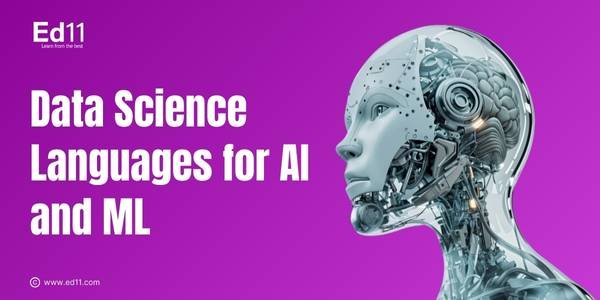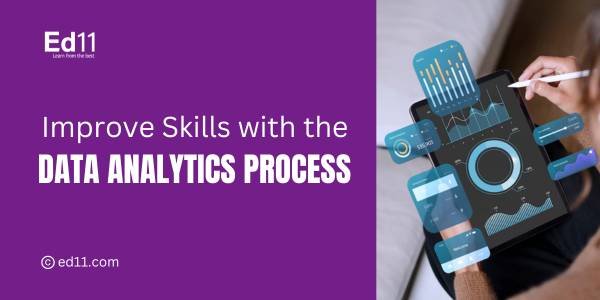Data Science Languages for AI and ML
Discover the best data science languages for AI and ML, including Python, R, SQL, Java, and C++. Learn which language suits your project needs and career goals.

Artificial Intelligence (AI) and Machine Learning (ML) are quickly evolving fields, and mastering the right data science languages is essential for success. As a Senior Data Analyst, you already understand the importance of working with large datasets, building predictive models, and deriving insights. But which Data Science Languages should you focus on for AI and ML? Let’s explore the most powerful data science languages that are shaping the future.
What is Data Science for AI and ML
Data science is the process of collecting, analyzing, and using data to make smart decisions. It helps Artificial Intelligence (AI) and Machine Learning (ML) by providing the right data to train models. AI uses data to learn and perform tasks like humans, while ML helps computers improve with experience. Data science cleans and organizes data so AI and ML can work better. It is used in chatbots, self-driving cars, and recommendation systems. Businesses use data science to predict trends and improve services. Learning data science can open many career opportunities.
Benefits of Data Science for AI and ML
-
Better Decision Making: Data science helps AI and ML analyze large datasets to identify patterns and trends. This allows businesses to make informed decisions based on real-time insights, reducing risks and improving efficiency.
-
Improves Accuracy: By learning from historical data, AI and ML models become smarter and more precise. Industries like finance and healthcare rely on data science to reduce errors and improve prediction accuracy.
-
Automates Tasks: AI and ML, powered by data science, automate repetitive tasks like data entry, customer support, and fraud detection. This saves businesses time and resources while increasing productivity.
-
Enhances Business Growth: Data-driven strategies help companies understand customer behavior, personalize services, and optimize marketing campaigns. AI-powered chatbots and recommendation systems improve customer experience and boost sales.
-
Future Innovations: Data science is shaping the future with AI advancements in robotics, voice recognition, and autonomous systems. Smart assistants like Siri and Alexa, as well as self-driving cars, are all powered by AI and ML innovations.
Why Choosing the Right Data Science Languages Matters
Python, R, and Julia are popular data science languages used for AI and ML development. These languages help in data processing, model training, and visualization. Python is widely preferred due to its vast libraries like TensorFlow and Scikit-learn. R is great for statistical analysis, while Julia offers high-speed computing. Choosing the right data science languages can improve AI and ML efficiency.
-
Process and analyze big data efficiently.
-
Build and fine-tune AI models.
-
Automate tasks and improve workflows.
-
Scale solutions for production environments.
1. Python: The King of Data Science Languages
Python leads the list of data science languages because it is easy to learn and use. It offers powerful libraries like TensorFlow, Pandas, and Scikit-learn for AI and ML development. Other data science languages like R and Julia are also used for statistical analysis and deep learning. However, Python remains the top choice due to its flexibility and strong community support. Learning Python can open doors to exciting careers in AI, ML, and data analytics.
Why Python for AI & ML?
-
Rich Libraries: Libraries like TensorFlow, Keras, Scikit-learn, and PyTorch make ML model development easier.
-
Ease of Learning: Simple syntax makes Python beginner-friendly.
-
Community Support: One of the largest programming communities provides ample learning resources.
When to Use Python: Python is the most popular among Data Science Languages due to its flexibility and powerful AI libraries. R is great for statistical analysis, while SQL is essential for data management. Learning multiple Data Science Languages enhances your AI and ML expertise.
2. R: A Strong Competitor in Data Science Languages
R is one of the most popular data science languages, especially for statistical analysis and visualization. It helps AI and ML models process complex data efficiently. Along with Python, R is widely used in research, finance, and healthcare industries. Its rich libraries support machine learning, making it valuable for data-driven projects. Learning R can boost career opportunities in AI, ML, and data science.
Why R for AI & ML?
-
Statistical Power: Strong in data visualization, statistical analysis, and hypothesis testing.
-
Machine Learning Packages: Packages like Caret, MLR, and RandomForest help in ML modeling.
-
Great for Data Exploration: Ideal for handling large datasets and exploratory data analysis.
When to Use R: R is one of the most powerful data science languages for statistical modeling and data visualization. While Python is widely used, R excels in analyzing complex datasets for AI & ML projects. Mastering multiple data science languages can enhance your career in data-driven industries.
3. Java: A Robust Data Science Language for AI & ML
Java is one of the popular data science languages used for building scalable AI and ML applications. It offers strong performance, security, and support for big data processing. Many enterprises prefer Java for AI models due to its reliability and integration with frameworks like Hadoop and Spark. Compared to other data science languages, Java is highly efficient for handling complex algorithms. Its vast libraries and tools make it a great choice for AI-driven solutions.
Why Java for AI & ML?
-
Scalability: Ideal for building large-scale AI applications.
-
Strong Performance: Faster than interpreted languages like Python and R.
-
Integration: Works well with big data frameworks like Apache Spark.
When to Use Java: Java is one of the most powerful data science languages for building scalable and high-performance AI applications. It is widely used in enterprise solutions, big data processing, and machine learning frameworks. Mastering multiple data science languages like Java, Python, and SQL can open new career opportunities in AI and ML.
4. Julia: A Rising Star in Data Science Languages
Julia is becoming one of the popular data science languages for AI and ML due to its speed and efficiency. It offers easy syntax like Python but delivers performance close to C++, making it ideal for large-scale computations. Many researchers prefer Julia for deep learning and mathematical modeling. Unlike some data science languages, Julia is designed for high-performance numerical computing. Its growing ecosystem makes it a strong choice for AI and machine learning applications.
Why Julia for AI & ML?
-
Speed: Faster than Python and R, making it ideal for complex computations.
-
Easy Syntax: Designed for data science and numerical computing.
-
Growing Libraries: MLJ.jl and Flux.jl provide ML capabilities.
When to Use Julia: Julia is one of the fastest data science languages, ideal for AI, deep learning, and high-performance computing. It offers speed like C++ while being as easy to use as Python. As AI grows, Julia is gaining popularity among researchers and data scientists.
5. SQL: The Essential Data Science Language for AI & ML
SQL is one of the important data science languages used for handling large datasets in AI and ML projects. It helps in retrieving, filtering, and organizing data before feeding it into machine learning models. While Python and R are popular for AI, SQL ensures efficient data management. Many AI applications rely on SQL databases for storing and processing structured data. Learning SQL is essential for data professionals working in AI and machine learning.
Why SQL for AI & ML?
-
Data Management: Used to store, retrieve, and manipulate large datasets.
-
Preprocessing: Helps clean and prepare data before feeding it into ML models.
-
Integration: Works well with Python, R, and Java.
When to Use SQL: SQL is one of the most important data science languages for managing and querying large datasets efficiently. It helps data scientists retrieve, filter, and analyze data stored in databases. Mastering SQL along with other data science languages like Python and R can improve your data handling skills.
6. C++: A Performance-Driven Data Science Language
C++ is one of the powerful data science languages used for high-speed processing in AI and ML. While Python is more popular, C++ is preferred for performance-intensive tasks like deep learning and real-time applications. Many AI libraries, such as TensorFlow and Caffe, have C++ support for faster execution. It helps optimize algorithms, making AI models more efficient. Combining C++ with other data science languages improves scalability and performance in machine learning projects.
Why C++ for AI & ML?
-
Speed and Efficiency: Ideal for performance-critical applications.
-
Deep Learning Frameworks: Many AI libraries, such as TensorFlow, have C++ implementations.
-
Embedded Systems: Used in AI applications running on hardware like self-driving cars.
When to Use C++: C++ is one of the fastest data science languages, making it ideal for AI applications that require high performance. Unlike Python, it offers better memory control and speed for deep learning models. Mastering multiple data science languages like C++, Python, and SQL can enhance your AI and ML skills.
Which Data Science Language Should You Choose
|
Data Science Language |
Best For |
|
Python |
General AI & ML, Deep Learning |
|
R |
Statistical AI & ML, Data Visualization |
|
Java |
Enterprise AI Applications |
|
Julia |
High-Performance AI & ML |
|
SQL |
Data Handling & Management |
|
C++ |
High-Performance AI & ML |
Choosing the right data science languages is crucial for AI and ML success. Python is the most popular due to its ease of use and rich libraries like TensorFlow and Scikit-learn. R is excellent for statistical analysis and data visualization, making it ideal for researchers. Java and C++ are preferred for high-performance AI applications, such as real-time processing. SQL is essential for managing and querying large datasets efficiently. Each language has its strengths, and learning multiple data science languages can boost your career opportunities. Companies seek professionals who can work with various tools and technologies. Knowing Python and SQL is a great starting point, but expanding to R, Java, or Scala can be beneficial. AI-powered industries like finance, healthcare, and e-commerce rely on these languages for data-driven decision-making. The demand for data science languages is growing, making it a valuable skill for AI and ML careers. Which data science languages do you use for AI and ML? Share your thoughts in the comments.
















